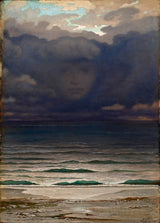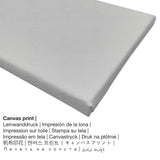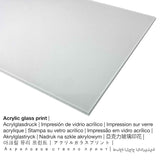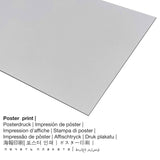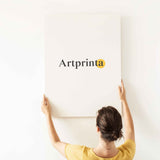Detalji ovog umjetničkog proizvoda
In 1870 Elihu Vedder made this piece of art. The artpiece has the following size: 20 5 × 16 cm (14/3 × 4 51,59/37,47 in) i slikana je tehnikom ulje na ploči od mahagonija. Štaviše, umjetnička djela čine dio kolekcije Muzej umjetnosti okruga Los Angeles, which is the largest art museum in the western United States, with a collection of more than 142.000 objects that illuminate 6.000 years of artistic expression across the globe. We are glad to reference that this javnosti artpiece is being included with courtesy of Los Angeles County Museum of Art (www.lacma.org).: . What is more, the alignment of the digital reproduction is in portret format sa omjerom 1: 1.4, što znači to dužina je 29% kraća od širine.
Materijali proizvoda koje naši kupci mogu odabrati
Za svaki proizvod nudimo niz različitih veličina i materijala. Dopuštamo vam da odaberete između sljedećih varijanti:
- Otisak iz akrilnog stakla: An print on acrylic glass, which is often referenced as a UV print on plexiglass, transforms your favorite original work of art into brilliant décor. Your work of art is being custom-made with the help of modern UV direct printing technology. This creates rich and sharp color shades.
- Štampa plakata (materijal na platnu): A poster print is a printed sheet of canvas with a granular structure on the surface, which reminds the original artwork. It is suited for putting your art copy with the help of a customized frame. Please keep in mind, that depending on the absolute size of the poster we add a white margin of something between 2-6cm around the artwork, which facilitates the framing with your custom frame.
- Aluminijski dvobojni otisak (metal): An Aluminium Dibond print is a material with an impressive depth effect. Its non-reflective surface make a contemporary look. For the Direct Aluminium Dibond option, we print the favorite artwork right onto the surface of the white-primed aluminum composite. Colors are vivid and luminous in the highest definition, details of the print are crisp and clear, and you can literally notice the matte appearance of the art print surface.
- Platno: The UV printed canvas material mounted on a wood frame. It creates the extra look of three dimensionality. The canvas makes a cosy and comfy feeling. How do I hang a canvas print on my wall? The advantage of canvas prints is that they are relatively low in weight, which means that it is easy and straightforward to hang up the Canvas print without any wall-mounts. Canvas prints are suitable for any type of wall.
Važna informacija: We try all that we can in order to depict our products as accurate as possible and to exhibit them visually on the respective product detail pages. Still, the pigments of the printing material, as well as the print result might differ slightly from the presentation on your device's screen. Depending on your screen settings and the quality of the surface, not all colors are printed one hundret percent realistically. Since our fine art prints are processed and printed manually, there might as well be slight variations in the motif's exact position and the size.
Informacije o strukturiranim člancima
| Klasifikacija proizvoda: | likovni tisak |
| Metoda reprodukcije: | digitalna reprodukcija |
| Način proizvodnje: | UV direktni ispis (digitalni tisak) |
| produkcija: | proizvedeno u Njemačkoj |
| Vrsta zaliha: | na zahtjev |
| Upotreba proizvoda: | dizajn kuće, zidna dekoracija |
| Orijentacija: | portretni format |
| Omjer: | 1: 1.4 dužina do širine |
| Značenje omjera slike: | dužina je 29% kraća od širine |
| Dostupni materijali proizvoda: | metalni otisak (aluminijski dibond), akrilni stakleni otisak (s pravim staklenim premazom), print plakata (platneni papir), platneni otisak |
| Platno na okviru nosila (print na platnu): | 50x70cm - 20x28 ", 100x140cm - 39x55" |
| Štampanje od akrilnog stakla (sa pravim staklenim premazom): | 50x70cm - 20x28 ", 100x140cm - 39x55" |
| Varijante štampe plakata (papir na platnu): | 50x70cm - 20x28 " |
| Opcije Dibond štampe (aluminijev materijal): | 50x70cm - 20x28 ", 100x140cm - 39x55" |
| Uokvirivanje umetničke kopije: | imajte na umu da ovaj umjetnički otisak nema okvir |
Strukturirane informacije o umjetničkom djelu
| Naslov slike: | "Memory" |
| klasifikacija: | slika |
| Umjetnička klasifikacija: | moderna umjetnost |
| Privremena klasifikacija: | 19th stoljeća |
| Nastalo u godini: | 1870 |
| Približna starost umjetničkog djela: | preko 150 godina |
| Slikano na: | ulje na ploči od mahagonija |
| Veličina originalnog umetničkog dela: | 20 5 × 16 cm (14/3 × 4 51,59/37,47 in) |
| Izloženo u: | Muzej umjetnosti okruga Los Angeles |
| Lokacija muzeja: | Los Angeles, Kalifornija, Sjedinjene Američke Države |
| Web stranice: | Muzej umjetnosti okruga Los Angeles |
| Vrsta licence: | javnosti |
| Ljubaznošću: | Muzej umjetnosti okruga Los Angeles (www.lacma.org) |
Detalji o izvođaču
| Umjetnik: | Elihu Vedder |
| Dodatni nazivi: | Vedder, Veder Elihu, vedder elihus, Elihu Vedder, e. vedder, Vedder Elihu |
| Pol izvođača: | muški |
| Nacionalnost umjetnika: | američki |
| Zanimanja: | pjesnik, slikar |
| Zemlja porijekla: | Sjedinjene Države |
| Klasifikacija umjetnika: | moderni umjetnik |
| Starost kod smrti: | 87 godina |
| Godina rođenja: | 1836 |
| Mjesto rođenja: | New York City, država New York, Sjedinjene Države |
| Umro: | 1923 |
| Preminuli u (mjesto): | Rim, romska provincija, Lacio, Italija |
© Autorska prava od, www.artprinta.com (Artprinta)
Original artwork information as provided from Los Angeles County Museum of Art (© - Muzej umjetnosti okruga Los Angeles - Muzej umjetnosti okruga Los Angeles)
Notes from the Curator:
Memory is one of Vedder’s most symbolic paintings. Although it at first appears to be a straightforward nocturnal view of the beach and ocean, upon close scrutiny one sees a faint human face emerge in the cloudy sky. Similar images of a floating head appear in a group of Vedder’s drawings from the late 1860s. Later he would be fascinated by the related classical motif of the head of Medusa. The theme of floating and severed heads was popular with the English Pre-Raphaelites, and at the end of the century it became a characteristic motif of the symbolists. Artists used such imagery to suggest states of mind and ideas of a personal nature rather than to describe the material world.
The art historian Regina Soria has identified two of the artist’s drawings as bases for the museum’s painting: The Face in the Clouds, 1866 (Wunderlich & Co., New York, as of 1987), which was illustrated in Vedder’s autobiography The Digressions of V. (p. 287), and a small drawing done the next year with the title Memory inscribed on its original mat (LACMA, see illustration).
As the 1867 drawing was executed on March 19, the birthday of Carrie Rosekrans, Vedder’s fiancée at that time, it has been assumed that the head in the two drawings and the oil painting was that of Rosekrans. If the drawings were intended to be portraits of Rosekrans, they would have had to have been done from memory for she was not with Vedder at the times of their execution. Actually, it is difficult to ascertain either the sex or the age of the face in any of the three.
The head may be that of a child. When Vedder painted Memory, Rosekrans was pregnant with their first child, and some seven years later he was commissioned by a Mr. and Mrs. J. R. Dumaresq to make a similar painting using the face of their recently deceased son. Will South has noted that at least one contemporary of Vedder’s, English critic William Davies, referred to the head in the drawing Memory with the neuter "it" (Art Pictorial and Industrial: An Illustrated Magazine 1 [September 1870]: 49).
In none of Vedder’s own writings does he suggest a particular person or type as the model for the floating head. Perhaps the ambiguity of the sex and age of the head was intentional, for such imagery accords well with the artist’s lifelong fascination with imaginative subjects and his enthusiasm for a sense of mystery.
According to the artist’s annotation of the 1866 drawing The Face in the Clouds, he was inspired to create such a meditative image by Alfred Lord Tennyson’s poem, "Break, Break, Break" (published 1842), in which the poet contemplates the sea and broods over the memory of lost ones. In Vedder’s painting the insubstantial, miragelike face, in contrast to the sharp reality of the shore and waves, suggests the transitory nature of life and the dreamlike quality of memory. In its quiet, mysterious mood the painting is quite evocative. The mauve palette and spectral quality of the night lighting also place Memory within the formal and conceptual tenets of late nineteenth-century symbolism. In fact, Memory ranks as one of the earliest symbolist images by an American.
Notes from the Contributor: Painting by Elihu Vedder (Museum: Los Angeles County Museum of Art)

